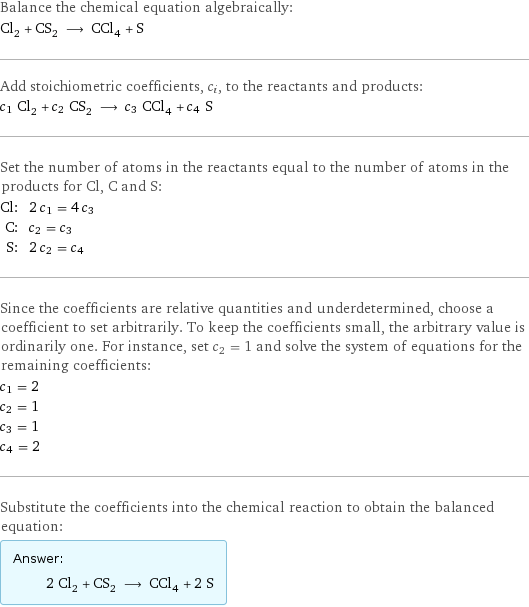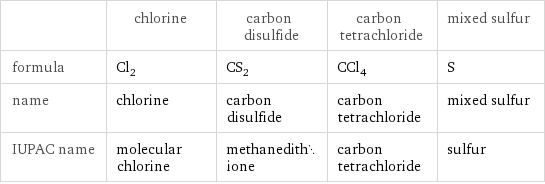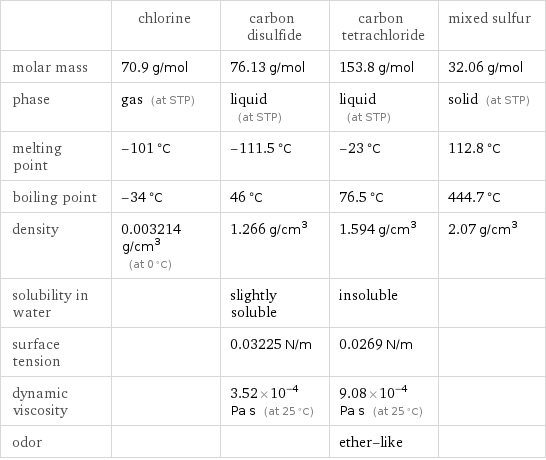Input interpretation

Cl_2 chlorine + CS_2 carbon disulfide ⟶ CCl_4 carbon tetrachloride + S mixed sulfur
Balanced equation

Balance the chemical equation algebraically: Cl_2 + CS_2 ⟶ CCl_4 + S Add stoichiometric coefficients, c_i, to the reactants and products: c_1 Cl_2 + c_2 CS_2 ⟶ c_3 CCl_4 + c_4 S Set the number of atoms in the reactants equal to the number of atoms in the products for Cl, C and S: Cl: | 2 c_1 = 4 c_3 C: | c_2 = c_3 S: | 2 c_2 = c_4 Since the coefficients are relative quantities and underdetermined, choose a coefficient to set arbitrarily. To keep the coefficients small, the arbitrary value is ordinarily one. For instance, set c_2 = 1 and solve the system of equations for the remaining coefficients: c_1 = 2 c_2 = 1 c_3 = 1 c_4 = 2 Substitute the coefficients into the chemical reaction to obtain the balanced equation: Answer: | | 2 Cl_2 + CS_2 ⟶ CCl_4 + 2 S
Structures

+ ⟶ +
Names

chlorine + carbon disulfide ⟶ carbon tetrachloride + mixed sulfur
Equilibrium constant
![Construct the equilibrium constant, K, expression for: Cl_2 + CS_2 ⟶ CCl_4 + S Plan: • Balance the chemical equation. • Determine the stoichiometric numbers. • Assemble the activity expression for each chemical species. • Use the activity expressions to build the equilibrium constant expression. Write the balanced chemical equation: 2 Cl_2 + CS_2 ⟶ CCl_4 + 2 S Assign stoichiometric numbers, ν_i, using the stoichiometric coefficients, c_i, from the balanced chemical equation in the following manner: ν_i = -c_i for reactants and ν_i = c_i for products: chemical species | c_i | ν_i Cl_2 | 2 | -2 CS_2 | 1 | -1 CCl_4 | 1 | 1 S | 2 | 2 Assemble the activity expressions accounting for the state of matter and ν_i: chemical species | c_i | ν_i | activity expression Cl_2 | 2 | -2 | ([Cl2])^(-2) CS_2 | 1 | -1 | ([CS2])^(-1) CCl_4 | 1 | 1 | [CCl4] S | 2 | 2 | ([S])^2 The equilibrium constant symbol in the concentration basis is: K_c Mulitply the activity expressions to arrive at the K_c expression: Answer: | | K_c = ([Cl2])^(-2) ([CS2])^(-1) [CCl4] ([S])^2 = ([CCl4] ([S])^2)/(([Cl2])^2 [CS2])](../image_source/e7d8c0d870f23f8d2ef9a84dcc0f5d3d.png)
Construct the equilibrium constant, K, expression for: Cl_2 + CS_2 ⟶ CCl_4 + S Plan: • Balance the chemical equation. • Determine the stoichiometric numbers. • Assemble the activity expression for each chemical species. • Use the activity expressions to build the equilibrium constant expression. Write the balanced chemical equation: 2 Cl_2 + CS_2 ⟶ CCl_4 + 2 S Assign stoichiometric numbers, ν_i, using the stoichiometric coefficients, c_i, from the balanced chemical equation in the following manner: ν_i = -c_i for reactants and ν_i = c_i for products: chemical species | c_i | ν_i Cl_2 | 2 | -2 CS_2 | 1 | -1 CCl_4 | 1 | 1 S | 2 | 2 Assemble the activity expressions accounting for the state of matter and ν_i: chemical species | c_i | ν_i | activity expression Cl_2 | 2 | -2 | ([Cl2])^(-2) CS_2 | 1 | -1 | ([CS2])^(-1) CCl_4 | 1 | 1 | [CCl4] S | 2 | 2 | ([S])^2 The equilibrium constant symbol in the concentration basis is: K_c Mulitply the activity expressions to arrive at the K_c expression: Answer: | | K_c = ([Cl2])^(-2) ([CS2])^(-1) [CCl4] ([S])^2 = ([CCl4] ([S])^2)/(([Cl2])^2 [CS2])
Rate of reaction
![Construct the rate of reaction expression for: Cl_2 + CS_2 ⟶ CCl_4 + S Plan: • Balance the chemical equation. • Determine the stoichiometric numbers. • Assemble the rate term for each chemical species. • Write the rate of reaction expression. Write the balanced chemical equation: 2 Cl_2 + CS_2 ⟶ CCl_4 + 2 S Assign stoichiometric numbers, ν_i, using the stoichiometric coefficients, c_i, from the balanced chemical equation in the following manner: ν_i = -c_i for reactants and ν_i = c_i for products: chemical species | c_i | ν_i Cl_2 | 2 | -2 CS_2 | 1 | -1 CCl_4 | 1 | 1 S | 2 | 2 The rate term for each chemical species, B_i, is 1/ν_i(Δ[B_i])/(Δt) where [B_i] is the amount concentration and t is time: chemical species | c_i | ν_i | rate term Cl_2 | 2 | -2 | -1/2 (Δ[Cl2])/(Δt) CS_2 | 1 | -1 | -(Δ[CS2])/(Δt) CCl_4 | 1 | 1 | (Δ[CCl4])/(Δt) S | 2 | 2 | 1/2 (Δ[S])/(Δt) (for infinitesimal rate of change, replace Δ with d) Set the rate terms equal to each other to arrive at the rate expression: Answer: | | rate = -1/2 (Δ[Cl2])/(Δt) = -(Δ[CS2])/(Δt) = (Δ[CCl4])/(Δt) = 1/2 (Δ[S])/(Δt) (assuming constant volume and no accumulation of intermediates or side products)](../image_source/04ab1e3292046b764ad46d670a8e822c.png)
Construct the rate of reaction expression for: Cl_2 + CS_2 ⟶ CCl_4 + S Plan: • Balance the chemical equation. • Determine the stoichiometric numbers. • Assemble the rate term for each chemical species. • Write the rate of reaction expression. Write the balanced chemical equation: 2 Cl_2 + CS_2 ⟶ CCl_4 + 2 S Assign stoichiometric numbers, ν_i, using the stoichiometric coefficients, c_i, from the balanced chemical equation in the following manner: ν_i = -c_i for reactants and ν_i = c_i for products: chemical species | c_i | ν_i Cl_2 | 2 | -2 CS_2 | 1 | -1 CCl_4 | 1 | 1 S | 2 | 2 The rate term for each chemical species, B_i, is 1/ν_i(Δ[B_i])/(Δt) where [B_i] is the amount concentration and t is time: chemical species | c_i | ν_i | rate term Cl_2 | 2 | -2 | -1/2 (Δ[Cl2])/(Δt) CS_2 | 1 | -1 | -(Δ[CS2])/(Δt) CCl_4 | 1 | 1 | (Δ[CCl4])/(Δt) S | 2 | 2 | 1/2 (Δ[S])/(Δt) (for infinitesimal rate of change, replace Δ with d) Set the rate terms equal to each other to arrive at the rate expression: Answer: | | rate = -1/2 (Δ[Cl2])/(Δt) = -(Δ[CS2])/(Δt) = (Δ[CCl4])/(Δt) = 1/2 (Δ[S])/(Δt) (assuming constant volume and no accumulation of intermediates or side products)
Chemical names and formulas

| chlorine | carbon disulfide | carbon tetrachloride | mixed sulfur formula | Cl_2 | CS_2 | CCl_4 | S name | chlorine | carbon disulfide | carbon tetrachloride | mixed sulfur IUPAC name | molecular chlorine | methanedithione | carbon tetrachloride | sulfur
Substance properties

| chlorine | carbon disulfide | carbon tetrachloride | mixed sulfur molar mass | 70.9 g/mol | 76.13 g/mol | 153.8 g/mol | 32.06 g/mol phase | gas (at STP) | liquid (at STP) | liquid (at STP) | solid (at STP) melting point | -101 °C | -111.5 °C | -23 °C | 112.8 °C boiling point | -34 °C | 46 °C | 76.5 °C | 444.7 °C density | 0.003214 g/cm^3 (at 0 °C) | 1.266 g/cm^3 | 1.594 g/cm^3 | 2.07 g/cm^3 solubility in water | | slightly soluble | insoluble | surface tension | | 0.03225 N/m | 0.0269 N/m | dynamic viscosity | | 3.52×10^-4 Pa s (at 25 °C) | 9.08×10^-4 Pa s (at 25 °C) | odor | | | ether-like |
Units
